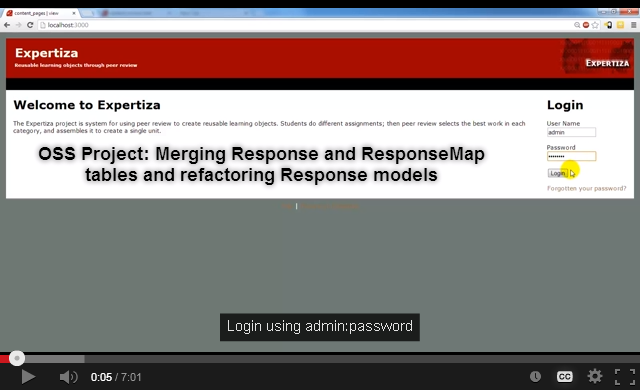CSC/ECE 517 Fall 2013/oss E806 jlv
E806 Remove ResponseMaps
The primary aim of this project was to create a data migration that merges all data from response_maps table to responses table.
| Revision history | |||||
|---|---|---|---|---|---|
| Date | Changes | ||||
| 10/30/2013 | Updated section on testing: - Added link to YouTube demo | ||||
| 10/29/2013 | Updated section on design: - Added existing and new Database design - Added existing and new Models design | ||||
| 10/28/2013 | Initial version | ||||
Introduction
Expertiza
Expertiza is a web application where students can submit and peer-review learning objects (articles, code, web sites, etc). It is used in select courses at NC State and by professors at several other colleges and universities.<ref name='expertizagithub'>Kofink, A. (2013, July). expertiza @ GitHub Retrieved from https://github.com/expertiza/expertiza</ref>
OSS Project
Classes
- response_map.rb (94 lines)
- feedback_response_map.rb (29 lines)
- metareview_response_map.rb (107 lines)
- participant_review_response_map.rb (5 lines)
- review_response_map.rb (97 lines)
- team_review_response_map.rb (5 lines)
- teammate_review_response_map.rb (104 lines)
- response.rb (171 lines)
What they do?
Responses (all kinds) are instances of filled-out rubrics. When someone responds to a rubric, a response is created. There are different kind of responses for different kinds of rubrics. A response_map keeps track of who is the reviewer and who is being reviewed. ResponseMaps have a 1 to 1 correspondence with Responses.
What we did?
The following activities were carried out as part of the project:
- New data migration
- Since Responses have a 1 to 1 correspondence with ResponseMaps, we migrated the data from
response_mapstable toresponsestable. - Removing table
- After the above migration was complete, we removed the
response_mapstable from the database. - Refactoring
- We had to refactor the above listed classes to ensure that they continue to operate as expected after removal of the
response_mapstable.
Design
Database
Existing Design

In the existing design, there are two tables responses and response_maps. However, there is no need to maintain a separate table called response_maps since there is a 1:1 mapping between a responses and response_maps table entry.
responses- Maintains the version number, additional comment, created at, updated at and foreign key for
response_mapstable. response_maps- Maintains the mapping to reviewed object, reviewer and reviewee. It also maintains the type of the review - Feedback, Team Review, Meta Review, etc.
New Design

In the new design, there is only one table called responses. Each row in the responses table now contains the data from the corresponding row of the response_maps table.
In order to achieve this, we wrote a data migration that does the following:
- Altered
responsestable to add the missing columns fromresponse_mapstable - Updated these new columns in the
responseswith data fromresponse_mapstable by performing a join onresponses.map_idandresponse_maps.idfields. - Dropped the
response_mapstable
Models
Existing Design

In the existing design, there is a 1:1 composition relationship between Response and ResponseMap model i.e. Response has-a ResponseMap.
New Design

In the new design, since there is only one database table representing Response and ResponseMap models - we have an inheritance relationship as depicted above. The inheritance relationship allows us to localize the impact of the data migration. This was necessary because many models, views and controllers are using ResponseMap model. In this design, ResponseMap just forwards ActiveRecord calls to Response since columns from response_maps table are now in responses table.
Challenges
Challenge 1
Problem: ResponseMaps are created independently of Responses in the current version of the project. However, after merging these tables, we cannot really have a ResponseMap without a Response.
Resolution: We fixed this in a way that controller like grades_controller.rb creates an entry in the responses table and later response_controller.rb (create action) can update this entry.
Challenge 2
Problem: Existing code uses response.id and response_map.id. As per the outcome of our earlier discussions, there was a need to maintain the map_id. However, after aliasing map_id to id (in order to resolve calls from controllers), we found that some part of the code also refers to response.id
Resolution: Since the references to response.id are very few, 2 files to be specific. We updated these files to use a different attribute name i.e. response.response_id
Refactoring
Here are some examples of refactoring that were performed throughout the code:
Use of find()
We replaced instances of code that use the following version of find():
ResponseMap.find(:all, :conditions => ['reviewee_id = ? and reviewer_id = ?', participant.id, reviewer.id])
with the following version of find()
ResponseMap.find_all_by_reviewee_id_and_reviewer_id(participant.id, reviewer.id)
Unused code
In the following method, we found an unused local variable assignment_id that we removed.
def self.delete_mappings(mappings, force=nil)
failedCount = 0
mappings.each{
|mapping|
assignment_id = mapping.assignment.id
begin
mapping.delete(force)
rescue
failedCount += 1
end
}
return failedCount
end
Removing redundancy
We removed some redundancy in several parts of the code.
Testing
We have created a YouTube video that can help reviewers verify that this project works as expected.

Future work
The future work for this project involves:
- Reanaming all sub-classes of
ResponseMap, for example: FeedbackResponseMap, so that the names end in Response, for example: FeedbackResponse.
- Remove
ResponseMap model and have it's children inherit from Response instead.
- Refactor all models, controllers and views that use
ResponseMap to use Response.
References
<references />
Notes
- All references and further reading links are in the APA style
- All the content on this page is from websites that have a Attribution-NonCommercial-NoDerivs 3.0 or similar license that allows us to use their content.